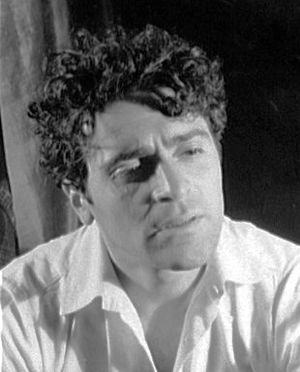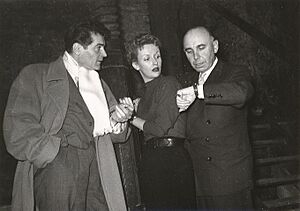Francis Lederer facts for kids
Quick facts for kids
Francis Lederer
|
|
|---|---|

Lederer in 1932
|
|
| Born |
František Lederer
November 6, 1899 |
| Died | May 25, 2000 (aged 100) Palm Springs, California, U.S.
|
| Resting place | Forest Lawn Cemetery, Cathedral City, California |
| Occupation | Actor |
| Years active | 1919–1971 |
| Spouse(s) | |
Francis Lederer (born November 6, 1899, in Prague – died May 25, 2000) was a famous actor. He was born in the Austro-Hungarian Empire, which is now part of the Czech Republic. He had a very successful career as a film and stage actor. He first became famous in Europe, then moved to the United States. His original name was Franz Lederer, or František in Czech.
Contents
Early Life and Beginnings
Francis Lederer grew up in Prague. When he was nine, his parents separated. Sadly, his brother also died in a war. Francis worked in a store that sold dry goods. His first experience with acting was cleaning shelves in the background of a play. He lost that small role because he drew too much attention to himself!
Acting Career Highlights
Becoming a Star in Europe
Francis Lederer started acting when he was young. He trained at the Academy of Music and Dramatic Art in Prague. After serving in the army during World War I, he began his stage career. He started with a small part in a play called Burning Heart.
He toured many countries like Moravia, Czechoslovakia, Hungary, Austria, and Germany. He quickly became a popular "matinee idol" in theaters. One of his most famous roles was playing Romeo in Romeo and Juliet.
In the late 1920s, Francis Lederer began acting in movies. He worked with famous directors and actresses. He starred in silent films like Pandora's Box and Atlantic (both from 1929). He also appeared in The Wonderful Lies of Nina Petrovna. He successfully moved from silent movies to movies with sound.
Moving to America
In 1931, Francis Lederer went to London to act in a play. The next year, he performed in a play called Autumn Crocus on Broadway in New York City. He used the name "Francis" for the first time. The play ran for 210 performances.
As the Nazi movement grew in Europe, life became difficult for Jewish people. Francis Lederer, who was Jewish, decided to stay in America. He became a U.S. citizen in 1939.
His first American movies included Man of Two Worlds (1934) and Romance in Manhattan (1934) with Ginger Rogers. He also starred in The Gay Deception (1935) and One Rainy Afternoon (1936).
Edward G. Robinson, another famous actor, praised Francis Lederer's acting. He played a German-American Bundist in Confessions of a Nazi Spy (1939). He also played a fascist in The Man I Married (1940). Later, he even played Count Dracula in the 1958 film The Return of Dracula.
Francis Lederer always took theater acting seriously. He studied with Elia Kazan at the Actors Studio in New York City. He often performed on stage. Some of his notable stage roles were in Golden Boy (1937) and The Diary of Anne Frank (1958).
He took breaks from making films to focus on his stage work. He returned to movies in 1944. He appeared in films like Voice in the Wind and The Bridge of San Luis Rey. He also starred in Jean Renoir's The Diary of a Chambermaid (1946).
His final film role was in Terror Is a Man in 1959. During the 1950s, he was the honorary mayor of Canoga Park.
Francis Lederer continued acting on television for another 10 years. He appeared in shows like The Untouchables and Mission: Impossible. His last TV appearance was in 1971. He played Dracula again in an episode of Night Gallery.
Personal Life and Legacy
Francis Lederer became very wealthy. He invested a lot in real estate, especially in the Canoga Park area of Los Angeles. He was very active in local community projects. He also helped with philanthropy and politics.
He served as a Recreation and Parks Commissioner for Los Angeles. He received awards for his efforts to make the city more beautiful. He was also the honorary mayor of Canoga Park for some time.
He cared deeply about peace movements. He taught acting and helped start two acting schools. These were the American National Academy of Performing Arts in Los Angeles and the International Academy of Performing Arts in Washington, D.C. In 2000, the Austrian government honored him. They gave him the Cross of Honor for Science and Arts, First Class.
Francis Lederer was married three times. His first marriage was to Ada Nejedly, an opera singer. They divorced in 1928. In 1937, he married actress Margo, but they divorced three years later.
His final marriage was to Marion Eleanor Irvine in 1941. They were married for almost 60 years until his death. Francis and Marion supported many community projects. They also helped with international humanitarian services, including UNICEF.
Francis Lederer worked until the week before he died. He passed away at the age of 100 in Palm Springs, California. He was one of the last surviving World War I veterans from the Austro-Hungarian Army. He is buried in the mausoleum at Forest Lawn Memorial Park.
Francis Lederer's Home
In 1934, Francis Lederer started designing his special home and stables. It was built on a hilltop in the Simi Hills in what is now West Hills, California. The house mixes Mediterranean Revival and Mission Revival styles.
Both his home and stables are protected as Los Angeles Historic-Cultural Monuments. After an earthquake in 1994, the property was completely fixed up. The estate is still owned by his family today.
Selected Films
European Films
- Zuflucht (1928)
- Pandora's Box (1929)
- Atlantik (1929)
- The Wonderful Lies of Nina Petrovna (1929)
- Maman Colibri (1929)
- Perjury (1929)
- The Great Longing (1930)
- The Road to Dishonour (1930)
- Susanne Cleans Up (1930)
- Her Majesty the Barmaid (1931)
- The Fate of Renate Langen (1931)
- Adventure in Vienna (1952)
- Stolen Identity (1953)
American Films
- Man of Two Worlds (1934)
- The Pursuit of Happiness (1934)
- Romance in Manhattan (1935)
- The Gay Deception (1935)
- One Rainy Afternoon (1936)
- My American Wife (1936)
- It's All Yours (1937)
- The Lone Wolf in Paris (1938)
- Midnight (1939)
- Confessions of a Nazi Spy (1939)
- The Man I Married (I Married a Nazi) (1940)
- Puddin' Head (1941)
- Voice in the Wind (1944)
- The Bridge of San Luis Rey (1944)
- The Diary of a Chambermaid (1946)
- The Madonna's Secret (1946)
- Million Dollar Weekend (1948)
- Surrender (1950)
- Captain Carey, U.S.A. (1950)
- Lisbon (1956)
- The Ambassador's Daughter (1956)
- The Return of Dracula (1958)
- Terror Is a Man (1959)
See also
 In Spanish: Francis Lederer para niños
In Spanish: Francis Lederer para niños
- List of Los Angeles Historic-Cultural Monuments in the San Fernando Valley
- List of centenarians (actors, filmmakers and entertainers)


